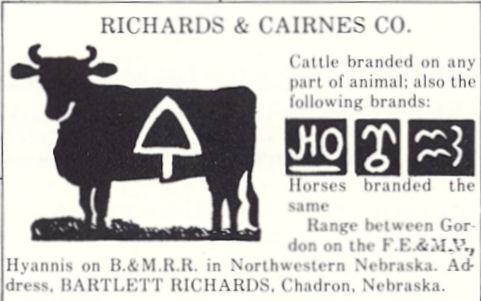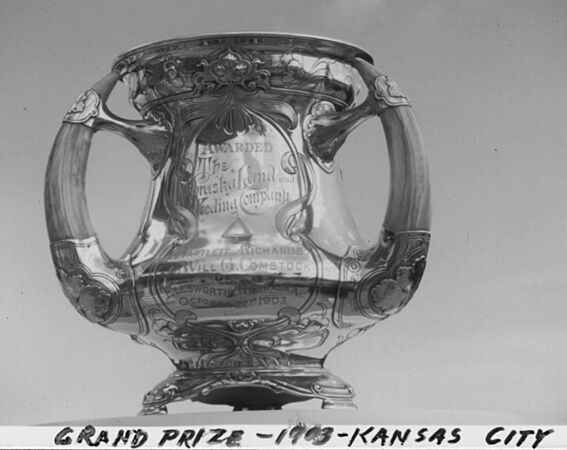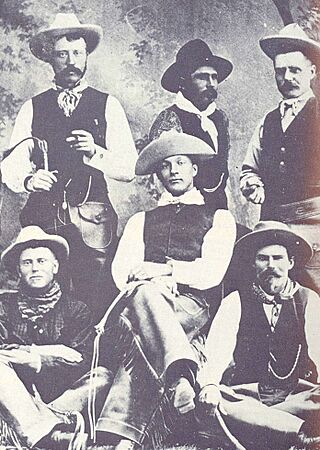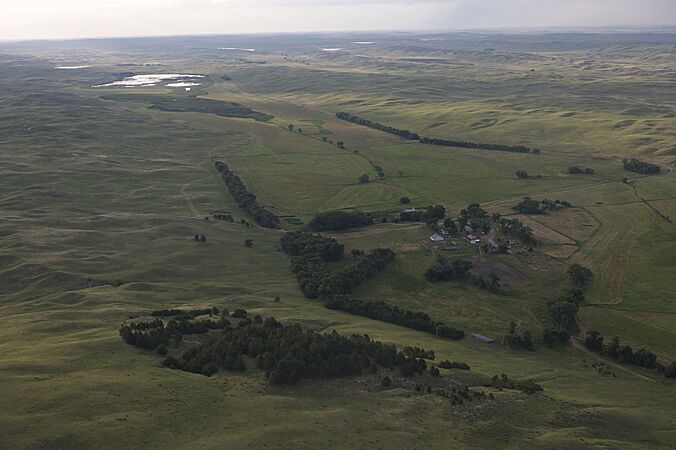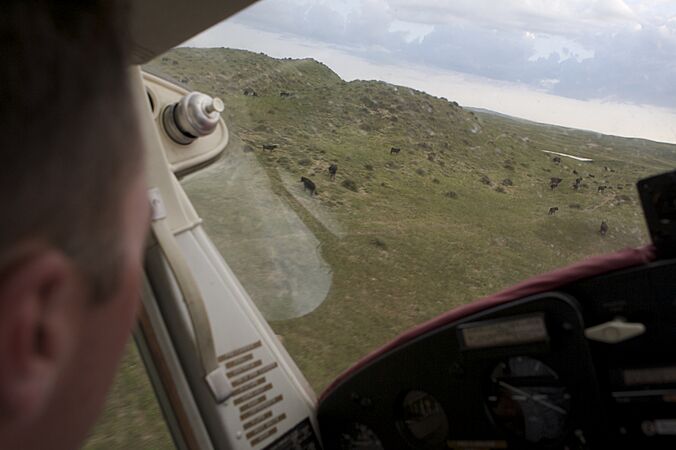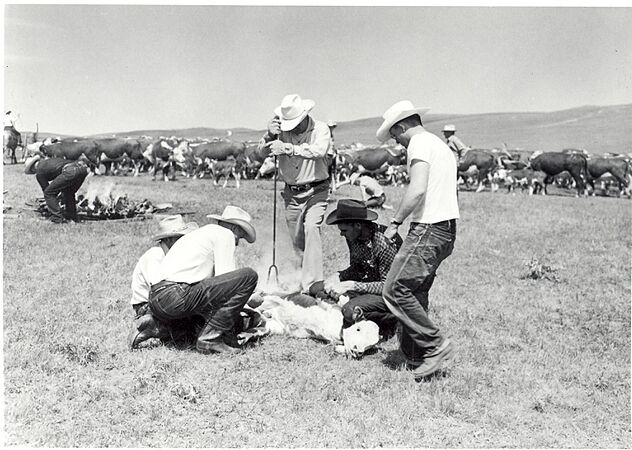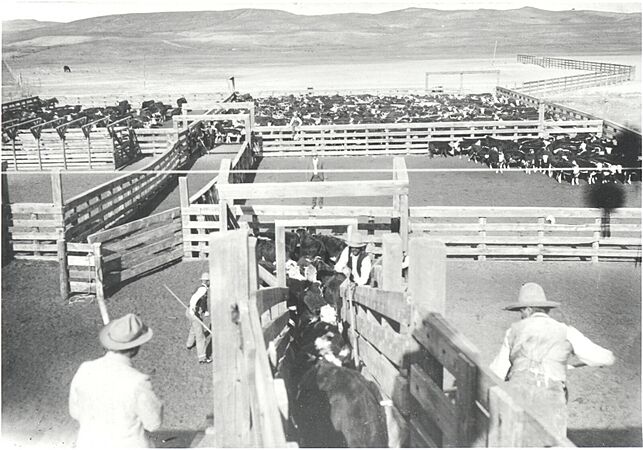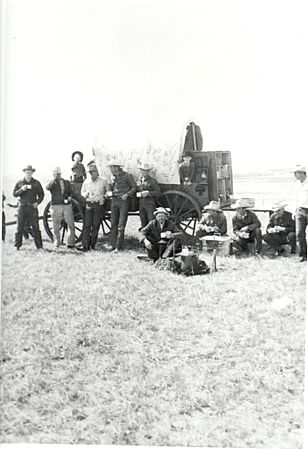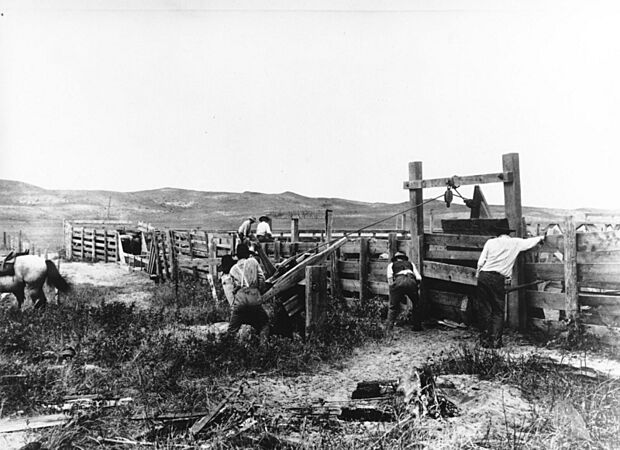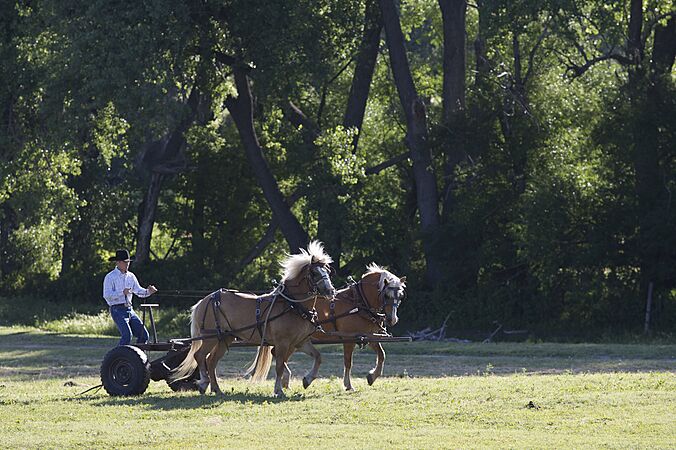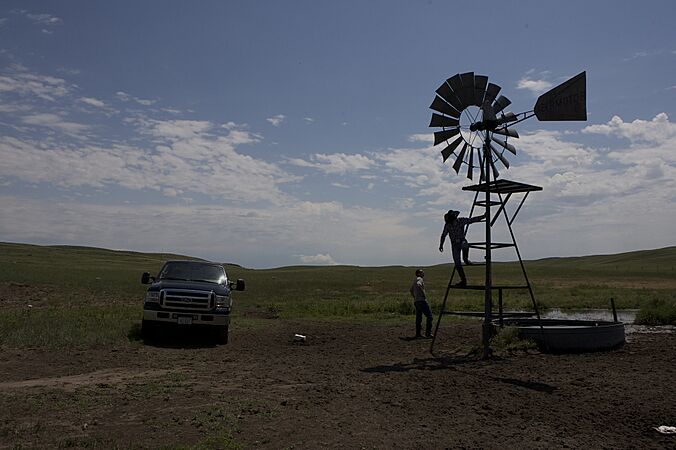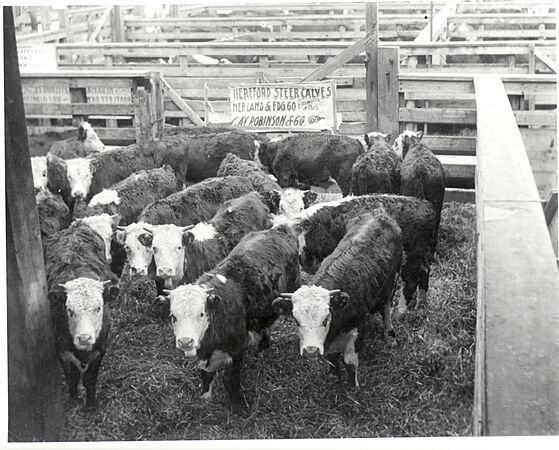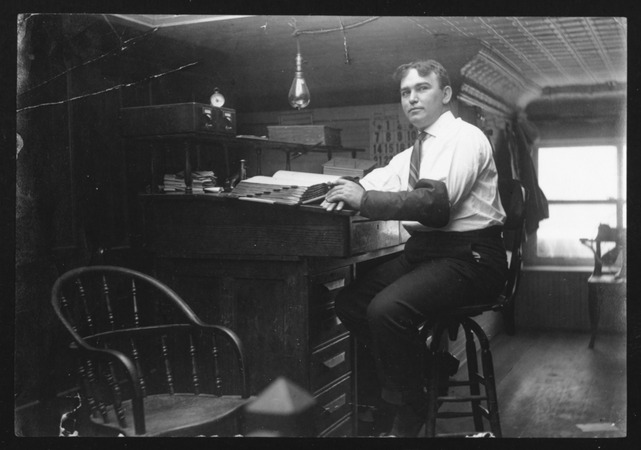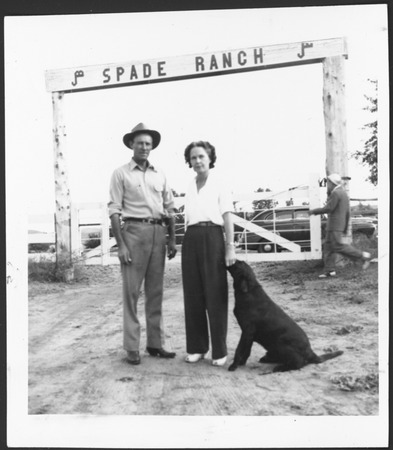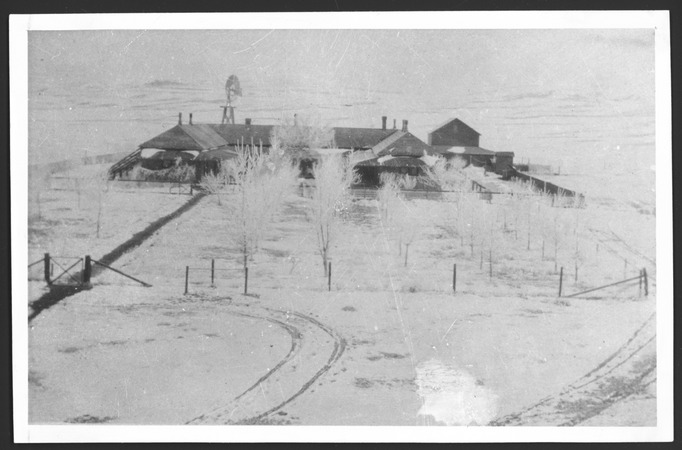Spade Ranch (Nebraska) facts for kids
Quick facts for kids |
|
|
Spade Ranch
|
|
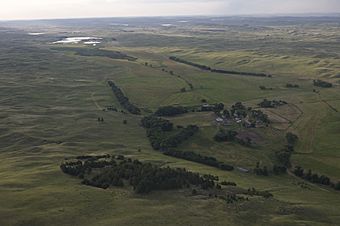
Aerial view of Spade Ranch in 2009
|
|
| Location | Sheridan / Cherry counties, Nebraska, USA |
|---|---|
| Nearest city | Ellsworth, Nebraska |
| Built | 1888 |
| NRHP reference No. | 80002464 |
| Added to NRHP | February 28, 1980 |
The Spade Ranch is a very large cattle ranch located in the Sandhills of western Nebraska. It sits between the towns of Gordon and Ellsworth. Bartlett Richards started the ranch in 1888. In 1980, the Spade Ranch was added to the National Register of Historic Places, which means it's an important historical site.
The Spade Ranch raises beef cattle in the Nebraska Sandhills. It covers land in both Sheridan and Cherry Counties. The founders, Bartlett Richards and William Comstock, ran the ranch successfully in the early 1900s. In 1905, when cattle could graze freely and there were good markets, the Spade Ranch was huge. It covered over 500,000 acres (200,000 ha) and had 60,000 cattle! Since 1923, the Bixby family has owned the ranch. They have continued to raise excellent beef cattle, helping Nebraska's big beef industry. The fact that this area is still cattle country today shows how smart those early ranchers were.
The Spade Ranch got its name from the special mark, or brand, that Bartlett Richards and William Comstock used on their cattle. This brand looks like the "Ace of Spades" card. The Spade brand is still used on the ranch's cattle today.
Contents
History of the Spade Ranch
How the Ranch Started and Grew
Nebraska's cattle industry first grew along rivers like the Platte and Republican. In 1878, H.L. Newman started a ranch near Gordon, Nebraska. His ranch had 15,000 cattle. At first, cattlemen avoided the Sandhills. But in 1879, a storm pushed some of Newman's cattle into the Sandhills. A group of cowboys went to find them. They found not only their lost cattle but also wild cattle that were healthy and fat. This showed how good the Sandhills were for grazing. One of the cowboys on that trip was James Dahlman, who later became mayor of Omaha.
News of this successful trip spread. Soon, ranches filled the land along the Niobrara River. But no ranch had its main buildings inside the Sandhills yet. Bennett Irwin, one of the cowboys from the 1879 trip, started claiming land in a large valley called Home Valley in 1884. This valley was perfect for a ranch because it could grow lots of hay.
On August 10, 1888, Bartlett Richards bought Irwin's land near Bean Soup Lake. He moved a log house from the Newman Ranch to Home Valley. This became the first building at the new Spade Ranch. In the 1890s, Richards organized his large ranch, which covered almost 800 square miles (2,100 km2). Ranching activities happened all year. In spring, they had calves and gathered cattle. In summer, they harvested hay for winter feed. In fall, they plowed fireguards and shipped cattle by train to markets in Omaha and Chicago. All year, they also built fences and supplied beef to Native American agencies.
The Spade Ranch was one of the biggest ranches near the Pine Ridge Indian Reservation. It supplied a lot of beef there. For example, in 1891, the Spade Ranch had a contract to provide 6 million pounds of beef, which meant 6,000 cattle! While the agency was good business, most cattle went to meat packers or feeders in the corn belt.
In 1895, Richards formed a business with John Cairnes. Later, in 1899, William Comstock joined Richards as a partner. They stayed partners until Richards passed away in 1911.
Richards set up the Spade Ranch's cattle shipping point in Ellsworth. In 1898, his company built a store, hotel, and stockyards there. The store was the ranch office, a general store, and a post office. The hotel offered free rooms for Spade Ranch cowboys.
In May 1899, Richards and Comstock's companies joined to form the Nebraska Land and Feeding Company. At that time, they had 16,000 cattle. They borrowed money to buy even more cattle.
William Comstock lived at the Spade Ranch headquarters, about 25 miles (40 km) north of Ellsworth. He had a sod house (a house made of sod), a ranch office, a bunkhouse for cowboys, the log cookhouse, a barn, and corrals. They also had a blacksmith shop and a machine shop. The ranch store sold groceries and supplies. Later, Comstock built a large house. Another house was built for the ranch foreman, Mike Peterson.
By 1899, telephone lines connected Gordon to Ellsworth. The "Ranch Telephone Company" was started with Richards as president. This connected the ranch headquarters to cattle shipping points like Ellsworth, Lakeside, and Bingham.
Richards moved his main office from Chadron to Ellsworth in 1901 to be closer to the ranch. He also built a brick house in Ellsworth.
Richards worked to improve the cattle breeding. He tried different feeds for calves and used windmills to get enough water. The Spade Ranch was also the first in the area to use a special livestock dip to remove parasites from cattle. In 1903, the Spade's Hereford cattle won a big prize at the American Royal Stock Show in Kansas City, Missouri.
Protecting Ranch Land
In 1901, Richards fenced off 250,000 acres (100,000 ha) of land north of Ellsworth. This area included government land with many water sources for cattle. Fencing helped keep cattle from wandering and protected breeding. To keep settlers from claiming grazing lands, some ranches, like the Spade, paid people to claim small homesteads (160-acre (65 ha)) where the ranch had fences. These people would then let the ranch use the land. This method helped ranches protect their grazing areas. Some of the first people to file claims for the Spade Ranch were widows of Civil War veterans in 1902.
The Bixby Family Takes Over
After some financial troubles, the Spade Ranch's future was uncertain. But in 1923, two cattlemen, Edward M. Brass and Edward P. Meyers, leased the ranch. They were very smart about business. In 1924, Lawrence Y. Bixby, a cattleman who had worked for the ranch before, took over managing it.
Lawrence first came to the Spade Ranch in 1909 when he was 13. He grew up watching and working for the ranch owners. His father, James Bixby, moved to land near the Spade Ranch in 1908. Lawrence's mother, Jennie, worked as a cook at the Spade Headquarters Cookhouse. Lawrence helped her sometimes. In 1909, Lawrence and his father bought 28 heifers, starting Lawrence's own cattle herd.
In 1909, Bartlett Richards bought 20,000 cattle from Mexico. That November, a huge snowstorm hit. Lawrence remembered, "The Spade lost 10,000 of those cattle." He and his brother skinned cattle for money, and the cold weather caused more losses.
In 1925, Brass and Meyers arranged for Lawrence to buy hay and care for their cattle. Brass also helped Bixby with a down payment to buy 2,000 acres of Spade land. From 1925, Bixby slowly bought more parts of the old Spade Ranch. In 1926, Brass and Meyers suggested Bixby move to the ranch headquarters. That same year, Lawrence met Eleanor Riordan, a teacher, and they married in 1927.
Edward Brass passed away in 1929. Lawrence Bixby continued to run many cattle for Meyers. Even during the tough times of the 1930s, the ranch did well. In 1937, Lawrence's 13-year partnership with the company ended. He said, "We had 3,000 cows, 25,000 acres of the Spade and all I had to wonder was could I ever pay for it." By 1940, Bixby had bought back 40 square miles (100 km2) of the original Spade Ranch, including the main headquarters.
During his time as owner, Bixby planted thousands of trees and built airstrips for ranch airplanes. He also fixed up the Richards Home in Ellsworth. In 1965, the ranch headquarters had several houses, three bunkhouses, the old log cookhouse, a large horse barn, cattle dipping vats, and many other buildings for ranch work. Lawrence Bixby was very active in cattle organizations. In 1954, he donated money to help pave Nebraska Highway 27, which passed by the ranch.
Lawrence Bixby greatly admired Bartlett Richards. He helped Richards get into the National Cowboy Hall of Fame in 1970. In 1981, Bixby himself was honored there. In 1980, the original Spade Ranch headquarters was listed on the National Register of Historic Places.
After Lawrence Bixby passed away in 1982, his son James D. Bixby took over. Jim was a famous Calf Roper in rodeos. He kept a large group of Quarter Horses and continued the Spade's tradition of using only horses and cowboys for daily ranch work. Jim changed the cattle herd from Hereford to Angus because of changes in the market. Jim was very active until he passed away in 1990.
Since 1990, Jim's son, Bret Y. Bixby, has run the Spade Ranch. Bret is also a professional Steer Roper. Like his father and grandfather, Bret continues to use horses and riders for ranch operations.
The Spade Ranch Today
The Spade Ranch still operates today in the traditional western way. Most of the original buildings in the Home Valley are still used for their first purposes. Even though ranching has changed a lot since Richards and Comstock's time, cowboys and ranch hands still work for the Bixby family. Fewer employees are needed now because of new technology.
In July and August, hay is harvested from the large meadows to feed cattle in winter. Calving season starts in February and ends by early April. This is a very important time, and the calves need constant care. Large roundups happen in spring and fall to get cattle ready for market and for branding. Branding at the Spade is a big yearly event. Cowboys rope cattle from horseback, wrestle them by hand, and brand them with the Spade brand. The branding day usually ends with a big western dinner.
Cattle are no longer shipped by train. Instead, they travel by cattle truck. Airplanes are used to find cattle in large pastures, spot broken fences, and for other ranch business. The Bixby Black Angus cattle are known across the country for their high quality. The Bixby Family also works with the Nebraska State Historical Society and Chadron State College to help protect and study the Sandhills region of Nebraska.
While some ranches nearby are no longer working cattle ranches, the Spade Ranch continues to raise beef cattle. Lawrence Bixby carried on the work of Richards and Comstock, and his children and grandchildren continue his legacy today. The Spade Ranch is an important part of the history and landscape of Sheridan County, and it still is today.
Books About the Ranch
- Bartlett Richards: Nebraska Sandhills Cattleman was written by his son, Bartlett Richards, Jr. This book tells the story of Bartlett Richards, Sr., from when he first arrived in Wyoming in 1879. It covers his learning from powerful cattle owners, how he built his huge ranching businesses in Wyoming and Nebraska, and his life until he passed away in 1911.
- Lawrence Bixby: Preserver of the Old Spade Ranch was written by Ruth Van Ackeren and Robert M. Howard. This book tells the story of Lawrence Bixby. He took over the struggling Spade Ranch and built a new ranching success. He raised top-quality Hereford cattle, award-winning workhorses, and prize-winning Calf Roping Quarter Horses. He also worked hard to protect and preserve the ranch he called home.






